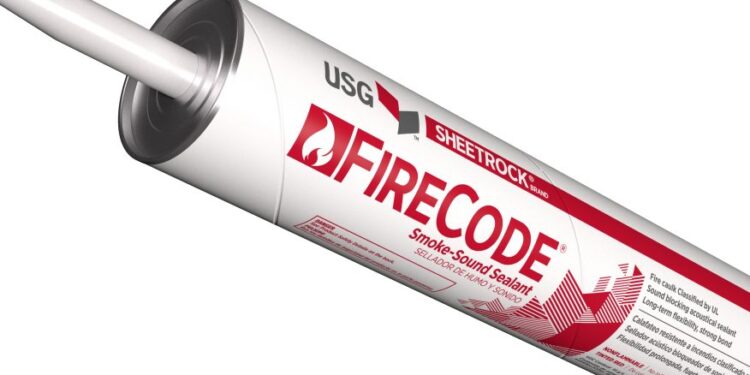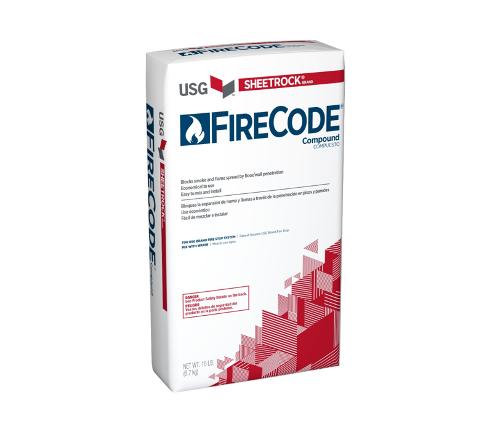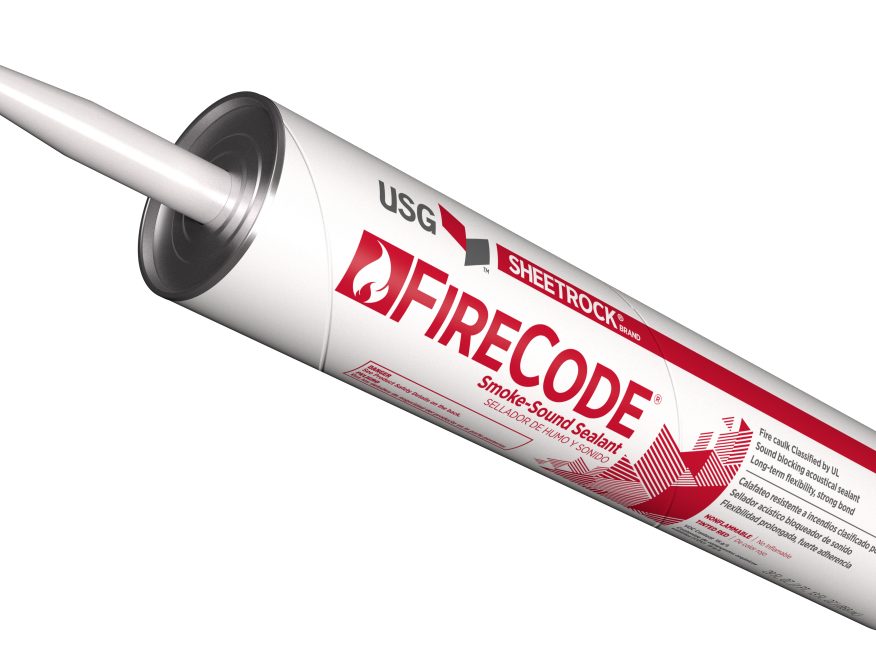USG Firecode Compound

Fire protection in building construction saves lives and goes beyond just meeting regulations. USG Firecode Compound creates fire-resistant assemblies that meet strict building codes. The International Building Code (IBC) outlines six methods to establish required fire resistance that meet accepted criteria in ASTM E119 or UL 263.
Contractors need to follow exact installation guidelines for fire-rated drywall applications, particularly with USG Sheetrock® Brand Firecode® Compound and firecode type X drywall. The IBC Section 2508.1 outlines installation requirements for gypsum board panels. The Gypsum Association’s GA-216 standard requires gaps at gypsum panel joints to stay under 1/4 inch and demands prefilling with joint compound. This specialized fire-rated joint compound handles temperatures up to 125°F. This is a big deal as it means that it performs differently from standard joint compounds. This piece covers everything professionals should know about installing USG Firecode Compound – from fire rating standards to common installation pitfalls.

Table of Contents
Understanding USG Firecode Compound
Construction professionals need to know about specialized materials like USG Firecode Compound to ensure building safety. This fire-resistant material is a vital part of creating firestops that block fire and smoke from spreading through building openings.
What is USG Sheetrock® Brand Firecode® Compound?
USG Sheetrock® Brand Firecode® Compound is a fire-resistant joint compound that creates effective firestops in buildings. You’ll need to mix this powder-based product with water before use, and it sets in about 2-3 hours. The compound dries to a red color that makes it easy for fire marshals to check during inspections.
Each batch gives you around 75 minutes of working time, which lets contractors finish their installations properly. The compound meets UL classification standards including ASTM E84 (ANSI/UL 723), ASTM E814 (ANSI/UL 1479), ULC-S115, and ASTM E1966 (ANSI/UL 2079).
This compound has an amazing feature – it bonds to already cured compound. This makes repairs and changes simple without affecting fire protection. The material works great with:
- Metallic pipes and conduits
- Electrical cables
- Through-penetration applications
- Head-of-wall systems
How it differs from regular joint compound
USG Firecode Compound is different from standard joint compounds because it’s made specifically for fire resistance. Regular compounds just finish drywall joints to look good, while Firecode Compound creates fire barriers inside wall assemblies.
The bright red color sets it apart from regular white or off-white joint compounds. Fire marshals love this because they can easily spot and verify proper installation of fire-rated systems.
The compound is also much tougher under extreme conditions. It hardens into a strong firestop that has passed high-pressure hose stream testing. Standard joint compounds would never hold up to these intense conditions.
Price is another key difference. While Firecode Compound costs more than regular joint compound, it’s much cheaper than other intumescent materials that can cost up to 600% more. This makes it a great choice for big projects that need lots of firestopping.
Is joint compound flammable?
Many people in construction wonder about joint compound flammability. USG Firecode Compound stands out with its fire-resistant properties. Tests show it has a flame spread rating of 0 and smoke developed rating of 0 under UL ASTM E84. These are the highest safety ratings possible.
The compound doesn’t contain silicones, solvents, halogens, PCBs, asbestos, or inorganic fibers. It’s a low VOC material under CDPH Standard Method V1.1 (CA Section 01350) and has GREENGUARD Gold certification. This makes it both safe for the environment and fire-resistant.
It’s worth mentioning that the compound has some limits. You shouldn’t use it where there’s constant moisture or extreme high temperatures. Hot water systems should stay below 140°F. The USG Fire Stop System can’t handle loads from people or vehicles in floor/ceiling setups.
Building codes say you must firestop all openings in fire-rated assemblies. This includes floor/ceilings, elevator shafts, stairwells, and corridors. Using USG Firecode Compound correctly helps keep fires contained – a key safety feature in modern buildings.
Fire Rating Standards and Compliance
Building safety depends on following fire rating standards and compliance protocols. Contractors who work with USG Firecode Compound need to understand these requirements. This will give a safe and compliant fire protection system in construction projects.
ASTM C475 and UL classification
USG Sheetrock® Brand Firecode® Compound meets ASTM C475, which sets the standard for joint compound used with gypsum wallboard. Note that the joint compound alone doesn’t have a fire rating. The entire wall assembly gets the fire rating designation.
The compound has earned impressive credentials with UL classification that meets several key standards:
- ASTM E84 (ANSI/UL 723) for surface burning characteristics
- ASTM E814 (ANSI/UL 1479) for through-penetration firestop systems
- ASTM E1966 (ANSI/UL 2079) for joint systems
- ULC-S115 for the Canadian market
These classifications help USG Firecode Compound work well in many UL systems for through-penetrations and head-of-wall applications. The material has gone through rigorous testing to perform in fire-rated assemblies.
GA-216 and ASTM C840 requirements
The International Building Code (IBC) Section 2508.1 points to two main standards for gypsum board installation: GA-216 from the Gypsum Association and ASTM C840. These standards spell out exact requirements for joint treatments that make fire ratings work.
Both standards have similar requirements for managing gaps:
- Gaps up to 1/8 inch can be prefilled with ready-mix or setting-type joint compound
- Gaps between 1/8 inch and 1/4 inch need prefilling with setting-type joint compound
- You’ll likely need to replace panels if gaps are slightly over 1/4 inch
You must prefill all gaps before inspection to avoid correction notices, whatever the application type. Many people miss this crucial compliance requirement.
Small gaps shouldn’t weaken the fire resistance of the whole assembly. The Gypsum Association’s GA-216 states that gypsum panels should “be in contact with one another but not forced together”. This moderate contact helps maintain structural integrity during fires.

ASTM C1280 for exterior applications
ASTM C1280 becomes the key standard when using USG Firecode Compound outside. The IBC clearly states that “gypsum sheathing shall be installed on exterior surfaces in accordance with ASTM C1280”.
This standard is different from interior applications, especially for gap management:
- Exterior installations need “neat fitting joints” (gaps up to 1/4 inch)
- You’ll need to replace boards or prefill with approved exterior-rated fire-rated setting-type joint compound if gaps exceed 1/4 inch
ASTM C1280 points out that gypsum sheathing board serves as a substrate that needs covering by exterior cladding or a weather-resistive barrier. It’s not meant for long-term exposure. You must protect USG Firecode Compound applications on exteriors properly.
The standard also requires that fire resistance details “shall be obtained from reports of fire-resistance tests, engineering evaluations, or listings from recognized fire testing laboratories”. This standard takes precedence when it’s stricter than fire-rated construction specifications.
Installers working with firecode type X drywall and USG Sheetrock® Brand Firecode® Compound should remember that following these standards goes beyond passing inspections. These standards help create reliable fire barriers that protect when needed most.
Interior Installation Guidelines
The right installation of USG Firecode Compound will keep fire barriers strong throughout a building’s lifetime. Following the guidelines carefully helps meet code requirements and saves lives if a fire breaks out.
Acceptable joint gap sizes
Interior installations need specific gap sizes between gypsum panels. Both GA-216 and ASTM C840 standards require “moderate contact” between panels—you should never force them together. The panels should touch but not compress against each other.
The gaps must stay within these limits:
- Gaps under 1/8 inch work fine with proper prefill
- Gaps from 1/8 inch to 1/4 inch need special treatment
- You’ll need to replace panels if gaps are bigger than 1/4 inch
These dimensions play a vital role in fire ratings. A single gap that’s too big can weaken the wall’s protection during a fire.
Prefill methods for gaps up to 1/4 inch
You have different prefill options based on the gap size:
For gaps under 1/8 inch:
- You can use ready-mix joint compound OR
- Setting-type joint compound
For gaps between 1/8 inch and 1/4 inch:
- You must use setting-type joint compound[131]
- USG Sheetrock® Brand Firecode® Compound works great here
Setting-type compounds don’t shrink as much as ready-mix options. You need to finish the prefill before inspection to avoid any issues.
When to replace panels
Sometimes you’ll need to replace panels even with good prefill techniques. Replace panels if:
- Damage is more than 100 square inches in a 100-square-foot area
- Gaps are just over 1/4 inch
- The fire barrier’s structure is weak
Small holes from doorknobs can be fixed with a flush patch. Bigger holes need new gypsum board installed back to the framing. The new panels must match the original type and thickness to keep the fire rating.
Fire-rated joint compound options
USG Sheetrock® Brand Firecode® Compound stands out for fire-rated installations. This compound has great features:
- It dries red so fire marshals can spot it easily
- You get about 75 minutes to work with each batch
- It creates a tough, durable firestop after hardening
- You can bond it to cured compound for easy repairs
The compound costs more than standard options but is much cheaper than intumescent materials, which can cost up to 600% more. This makes it perfect for big projects with lots of firestopping needs.
The building temperature must stay above 55°F during and after application. After it dries, you can sand it smooth and paint it with latex or oil-based paints.
Exterior Use Considerations
USG Firecode Compound’s exterior applications come with unique challenges compared to indoor installations. The building’s exterior envelope needs special consideration for weather exposure, building codes, and installation methods when using fire-rated materials.
Fire Rating Requirements for Exterior Walls
Building codes require specific fire ratings for exterior walls based on their distance from property lines or nearby structures. The code states that exterior walls “SHALL HAVE a fire resistance rating NOT LESS than that specified in Table 602”. Fire ratings become vital for buildings located within 30 feet of adjacent structures or property lines. The International Building Code bases its requirements on:
- Occupancy classification
- Construction type
- Fire separation distance
Fire-resistant exterior walls create significant compartmentalization that stops flames from spreading outside and “leapfrogging” back into upper floors. Some construction types still need to maintain the fire rating specified in Table 601, even when exterior walls extend beyond the 30-foot threshold where ratings might become zero.
ASTM C1280 Compliance for Sheathing
ASTM C1280 is the main standard that governs USG Firecode Compound’s exterior applications. The installation guidelines specify that “these panels shall be installed in accordance with GA-253, Application of Gypsum Sheathing, ASTM C1280, Standard Specification for Application of Gypsum Sheathing”.
The construction of fire-rated exterior assemblies “shall be installed in accordance with the UL/ULC Design”. Gypsum sheathing serves as a substrate that needs protection and “shall be covered by an exterior cladding or other weather-resistive barrier and is not intended for long-term exposure”.
Gap Filling for Exterior Applications
Exterior installations have specific gap filling requirements that differ from interior uses:
- Panels need a minimum 6mm (1/4 inch) gap where they meet masonry or similar materials to prevent moisture wicking
- A gap of 6mm (1/4 inch) to 12.7mm (1/2 inch) filled with sealant is required where panels meet horizontal surfaces like slabs or foundation walls
- The International Building Code requires control joints at maximum distances of 30 feet and at every building construction joint
USG Securock® Glass-Mat Sheathing with Firecode® provides 12 months of weather exposure protection. The material should not be exposed to “the eroding effects of cascading, pooling, and/or ponding water”. Proper exterior application will give both fire protection and moisture resistance in one system.
Common Mistakes and How to Avoid Them
Construction pros often run into trouble when they work with fire-resistant materials. These mistakes can happen to anyone – even seasoned contractors make errors that put building safety at risk and get pricey to fix.
Using the wrong type of compound
A common mistake happens when contractors substitute standard joint compound instead of USG Sheetrock® Brand Firecode® Compound in fire-rated assemblies. Regular joint compounds don’t have the fire-resistant properties needed to meet code requirements. Building inspectors in many areas look specifically for Firecode® Compound’s distinctive red color during their checks.
The mix-up between panel types creates similar headaches. Putting Type X drywall where Type C panels should go (or the other way around) is “a common jobsite error that can be a costly mistake”. These panels look almost identical, so contractors need to double-check their specs before they start installation.
New users should know that USG Firecode Compound has its limits. The product “should not be applied to moist areas or areas continuously immersed in water”. You also need to keep the building temperature “55°F (13°C) minimum during and after installation” to make sure it cures properly.
Skipping prefill before inspection
The biggest problem comes from not prefilling gaps before inspection. The City of Bellevue makes this crystal clear: “IMPORTANT: Regardless of the application (i.e., interior, or exterior) all gaps must be prefilled before the inspection to avoid correction notices”. This rule applies everywhere.
Technical mistakes during prefilling can cause serious issues. Too much water in the mix leads to cracking and poor bonding. On top of that, mixing old or sprayed material with fresh compound speeds up setting time and creates “substandard bond and unsatisfactory surface matrix hardness”.
Misunderstanding fire rating requirements
Problems with fire rating standards are systemic. Many contractors wrongly think they can leave any size gap or skip special joint treatments in fire-rated systems.
In stark comparison to this, fire code officials enforce strict gap size rules based on GA-216 and ASTM C840. Gaps between 1/8 inch and 1/4 inch need “setting-type joint compound, or firestopping material”. When gaps are slightly bigger than 1/4 inch, contractors must either “replace gypsum board” or “prefill with an approved fire-rated setting-type joint compound”.
Summing all up
USG Firecode Compound plays a vital role in modern building fire safety systems. This specialized material might seem minor in construction, but it creates barriers that save lives by stopping fire spread. Contractors should know what this product can and cannot do before they start the installation.
The right gap size management is crucial to maintain fire ratings. You’ll need to replace panels when gaps are bigger than 1/4 inch, and smaller gaps require setting-type compounds. The compound’s red color makes it easy for fire marshals to check compliance during inspections.
Projects with exterior applications just need extra care to protect against moisture and fire. ASTM C1280 lays out clear guidelines that help you manage gaps and shield against weather. Without doubt, these steps help fire and moisture protection work hand in hand.
Building pros should watch out for common mistakes. Safety gets compromised when someone uses wrong compounds, skips prefill steps, or doesn’t understand fire ratings – and fixes can get pricey. Following standards like GA-216 and ASTM C840 helps avoid these issues.
USG Firecode Compound costs more than regular joint compound, but it offers better fire protection than pricey intumescent options. This makes it a smart choice for big projects that need lots of firestopping around penetrations.
Fire protection ended up being more than just meeting codes – it’s an investment in safety. When pros understand and install USG Firecode Compound correctly, they build barriers that protect people when it matters most – during emergencies.
Here are some FAQs about the USG Firecode compound:
What does USG firecode mean?
USG Firecode refers to a specialized line of fire-resistant drywall products manufactured by USG Corporation. The USG Sheetrock® Brand Firecode® Compound is specifically formulated to provide enhanced fire protection in wall assemblies. When searching for USG firecode compound near me, you’re looking for these fire-rated building materials.
What is USG Fire Code C?
USG Fire Code C designates a particular type of fire-resistant drywall that offers extended fire protection duration. This USG Sheetrock Brand Firecode Compound provides superior fire resistance compared to standard drywall products. Contractors often seek where to buy USG firecode compound when specifying materials for fire-rated assemblies.
What is USG sheetrock used for?
USG Sheetrock is primarily used for creating interior walls and ceilings in residential and commercial construction. The USG Sheetrock Brand Firecode® Compound version is specifically designed for fire-rated applications where enhanced protection is required. These products are commonly found at building supply stores when searching USG firecode compound near me.
What is firecode drywall for?
Firecode drywall like the USG firecode compound is used in fire-rated wall assemblies to slow the spread of flames during a fire. The USG Sheetrock® Brand Firecode® Compound provides critical protection in building areas requiring fire resistance ratings. It’s commonly specified for use in garages, furnace rooms, and commercial buildings.
What does USG stand for in gypsum?
USG stands for United States Gypsum Company, the manufacturer of USG Sheetrock Brand Firecode Compound and other building products. The company produces various gypsum-based materials including the specialized USG firecode compound used in fire-rated construction. Their products are widely available at building suppliers when searching where to buy USG firecode compound.
Is firecode drywall mold resistant?
Standard USG firecode compound is not inherently mold resistant unless specifically labeled as such. However, USG does offer mold-resistant versions of their USG Sheetrock® Brand Firecode® Compound for moisture-prone areas. When searching USG firecode compound near me, be sure to check product specifications if mold resistance is required.

